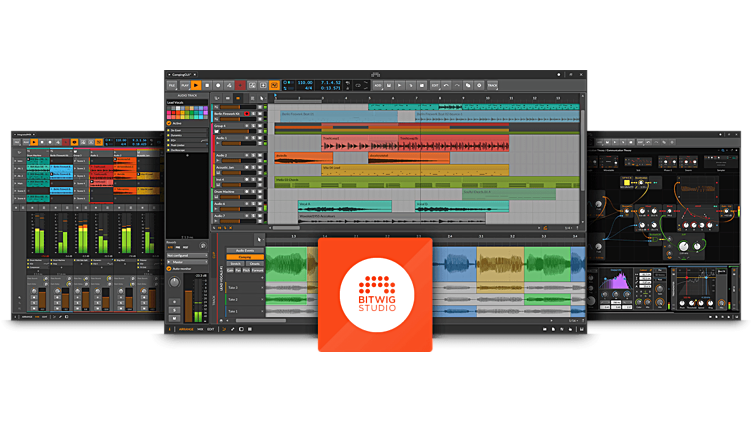Overview of Bitwig Studio
Bitwig Studio is a unique and innovative digital audio workstation (DAW) software that provides powerful tools for music production, performance and sound design. With its cutting-edge modular environment and flexible workflow, Bitwig gives producers, musicians and DJs greater creative freedom than traditional DAWs.
Compared to other major DAWs like Ableton Live, Logic Pro and FL Studio, some key aspects make Bitwig Studio stand out:
- Unified modulation system for easier automation of device and effect parameters
- Highly-customizable controller scripts created with Bitwig’s API
- Combine multiple devices into hybrid instruments and effects
- Compatibility across Windows, Mac and Linux platforms
- Polysynth and sampler instruments included in every license
“Bitwig gave me the tools that sparked so much creativity in my productions. With its super-flexible devices and modulation, I can shape any sound I want!” – Deadmau5, Bitwig Studio user
Bitwig Studio continues to push boundaries and deliver innovations that empower electronic musicians and unlock greater creative potential.
Key Features of Bitwig Studio
Bitwig Studio comes loaded with amazing features for sound design, composition, arranging, mixing and overal music production:
- Infinite potential with Bitwig’s modular environment
- Combine and route devices however you like
- Nest multiple devices into a single device
- Includes a massive Polysynth and Sampler
- Unified Modulation System for endless creative options
- Map modulators like LFOs to parameters
- Draw modulation curves for gradual or rhythmic changes
- Create dynamic soundscapes and textures
- Extensive library of high-quality effects
- Group common devices into instrument or effect racks
- Cutting-edge controller integration
- Assign parameters and map controllers intuitively
- API allows custom scripts for hardware devices
- Intuitive and fluid arrangement workflows
- Drag-and-drop audio, notes, automation
- Quickly experiment with song variations
- Export each track or the full mixdown

In a 2021 survey from Sound on Sound magazine, Bitwig Studio was rated the second most popular DAW with 17% of sound engineers choosing it as their number one music production software. The flexible environment and innovative features provide creators the tools they need to produce professional tracks and push creative boundaries.
Getting Started with Bitwig Studio
Whether you produce EDM tracks or play live instruments, Bitwig Studio has something to offer all musicians. Here’s an overview of how to get started:
System Requirements
It’s recommended to use a computer with at least these minimum specs for running Bitwig smoothly:
Windows
- 64-bit Windows 10 or later
- Quad-core CPU
- 16GB RAM
- 50GB free disk space (SSD recommended)
Mac
- 64-bit macOS 11 or later
- Apple M1 chip or Intel Core i5 CPU
- 16GB RAM
- 50GB disk space (SSD recommended)
Additional hardware like audio interfaces or MIDI controllers can enhance your production capabilities in Bitwig Studio.
Downloading and Installing
Get started in 3 steps:
- Visit Bitwig’s official website and select your operating system
- Choose between a free 30-day trial or purchasing a license
- Run the installer and follow the steps to get Bitwig authorized and activated
Paid licenses allow endless music creation in Bitwig Studio with full feature access, while trials have limited save/export capabilities.
Navigating the Interface
The Bitwig Studio user interface has several key sections:
- The Inspector houses device parameters and properties
- The Timeline displays arranged clips and automation
- The Mixer shows input/output routing and mixing
- Device panels hold instruments, effects racks and more
- Browsers to access plugins, presets and files
Customize the layout with multiple windows, detach panels or enter fullscreen modes for adaptable workflows. Most controls have tooltip overlays explaining what they do, very handy during first-time use.

Recording Audio in Bitwig Studio
Capturing audio is handled seamlessly no matter your gear or skill level:
Setting Up I/O Devices
The Preferences window is where audio interfaces, mixers or other hardware gets enabled. Choose input and output devices, adjust latency settings and map any controls.
Recording Audio Tracks
Recording modes include:
- Cycle – Repeated looped takes
- Auto Punch – Punch in/out on phrase loops
- Loop Record – Layered stacked takes
Set input levels appropriately and monitor sounds during recording. Export audio clips or full mixdowns when finished.
Using MIDI Controllers
Map buttons, knobs and faders to Bitwig Studio parameters using the intuitive MIDI learn functions. Hardware becomes hands-on control for instruments, transport and more.
“I customized my MIDI controller keys to trigger chords on Bitwig instruments and now I can play songs live without needing any music theory knowledge. It’s opened up so many possibilities!” – Jackie, singer-songwriter
Mixing and Effects in Bitwig Studio
Polish and professionalize tracks with Bitwig’s rich suite of effects devices:
The Mix Console
This is where tracks get balanced, panned, soloed/muted and routed:
- Each track gets a channel strip with level, pan and more
- Insert effects process the signal directly
- Sends add effects such as reverb auxes
Group related tracks like drums for easy collective mixing.
Bitwig’s Powerful Effects
From subtle enhancement to extreme sound design, these effects shine:
| Effect Type | Great For | Examples |
|---|---|---|
| EQs | Tonal balancing | DJ-style EQ with frequency spectrum analyzer |
| Graphic EQ for quick adjustments | ||
| Compressors | Controlling dynamics | Vintage optical compressor modeled on classics |
| Punchy modern compressor with listen mode | ||
| Distortions | Hard-hitting sounds | Amp stack simulator with cabinet models |
| Wave-shaping distorter for intense effects | ||
| Modulation | Rich, evolving textures | Chorus, flanger, phaser with flexible parameters |
| 14-waveform LFOs to modulate anything |
And much more like delays, vibratos and highly advanced effects…
Using Sends and Returns
Extra outputs called sends enable auxiliary tracks:
- Create effect racks on return tracks
- Use sends to route audio to these returns
- Returns remain unaffected when muting tracks
This facilitates studio techniques like parallel compression for drums.

Additional Resources
Here are useful materials to level up your Bitwig Studio skills:
- Video Tutorials – Bitwig’s YouTube channel and third-party creators
- Forums – Connect with and learn from other Bitwig users
- Sound Packs – New instruments/effects available from Bitwig Exchange
- Knowledge Base – Documentation and technical support info
“The more I learned sound design techniques for Bitwig’s Polysynth instrument, the more unique tones and textures I could develop for my tracks.” – Giselle, electronic music producer
Wrapping Up and Next Steps
Whether upgrading from another DAW or trying music production for the first time, explore the creative freedom you’ve been waiting for with Bitwig Studio.
Immerse yourself by:
- Getting hands-on with Bitwig’s intuitive interface
- Experimenting with track arrangement ideas
- Shaping amazing sounds through modulation
- Building custom instrument and effect racks
Now get ready to start making music beyond limits!



